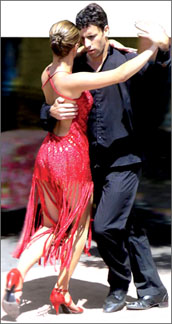Beautiful Tango
Argentina's National Dance:
by Bonnie Neely
Our concierge at the lovely Sheraton Hotel Libertador in Buenos Aires
suggested that our fist special evening in his country should be our
introduction to their national pride: The Tango.
 Of the many choices for a dinner show we were advised by several
afficianados to select the Esquina Carlos Gardel Dinner show, named for
the indisputable Tango idol if the early 1900's where tango started in
this El Abasto labor area. That famous singer instigated many street
corner festive evenings of song and dance, and in 1893 a restaurant,
Chanta Quatro, opened here where everyone gathered around Gardel. Of the many choices for a dinner show we were advised by several
afficianados to select the Esquina Carlos Gardel Dinner show, named for
the indisputable Tango idol if the early 1900's where tango started in
this El Abasto labor area. That famous singer instigated many street
corner festive evenings of song and dance, and in 1893 a restaurant,
Chanta Quatro, opened here where everyone gathered around Gardel.
The same restaurant, renovated and expanded to its Art Noveau beauty
of today, is where you'll find your very best introduction to Tango in
the classic style developed over a century right here in this place.
This is the best choice for both the meal and the performance!
A van picked us up at the hotel to take us to the elegant theater,
which is all in sophisticated black, white, and gold, with balcony
tables and long tables of main floor seating.
Every seat in the house is good. The meal is delicious with a full
and varied menu from which to select your three courses. I had my first
of the fork-tender, nearly an inch thick, juicy steak, the pride of
Argentina.
During our meal we enjoyed excellent wine and good conversation with
international couples near us. We also watched a film which gave the
history of Tango, Argentina's international contribution to music and
dance. Following dinner the fabulous Tango Show gave us 90 minutes of
thrilling entertainment.
Five couples began dancing at the same time on the sophisticated and
formal stage, each pair with its own unique style of dance, all in black
and white sparkling costumes, depicting the early 1900's when Tango
music was began in the streets and brothels and gained popularity
through guitar performances.
Tango drew the young during the Roaring Twenties while being
disparaged as scandalous and lewd by the older generations.
Perched above and just behind the dancers, the tango band played on a
brass stage and consisted of a piano, a bass, two violins and an
accordion, and a bandelino, with the artists dressed in formal attire.
Their music was lively, syncopated, and sensual, providing the
precise rhythms for the exquisite dances. Throughout the evening each
couple took turns claiming the stage and innovating its own
uniquely-stylized rendition of the basic eight steps of Tango.
The glitzy, beaded dresses were split to the hip, low-cut, resembling
swimsuits with scarves attached as skirts. Elaborately jewelled
headdresses were reminiscent of flapper days. The men were formally
dressed in various costumes to complement their partners' attire.
Locked together above the hips, the couples kept hips apart for the
wildly fast kicks and turns in the sexy, intricate, lively, and
faultless steps. We wondered how the dancers kept from tripping each
other as their legs quickly intertwined and kicked in front and back in
this fast-paced, energetic and beautiful ballet coupling.
The evening ended far too quickly, although it was after midnight. As
we were driven in the van back to our hotel we noticed several
pedestrian-only streets completely packed with people, like Bourbon
Street in New Orleans.
Discos, restaurants, and bars are popular from midnight till dawn on
any night for those who can sleep in the morning, or function without.
Morning seems to be the preferred sleep time for Argentinians. Because
dinner is a several- hour, large meal sometime after 9:30 at night,
breakfast is only coffee, juice, and maybe bread.
Lunch, at any time in the afternoon, may be an omelette or sandwich.
Many Argentinians enjoy teatime around 6 p.m., sipping their own mate
tea from a gourd hollowed into a small cup with a silver rim and foot.
Buenos Aires province has 12 million people, about one third of
Argentina's entire population of 38 million. |
